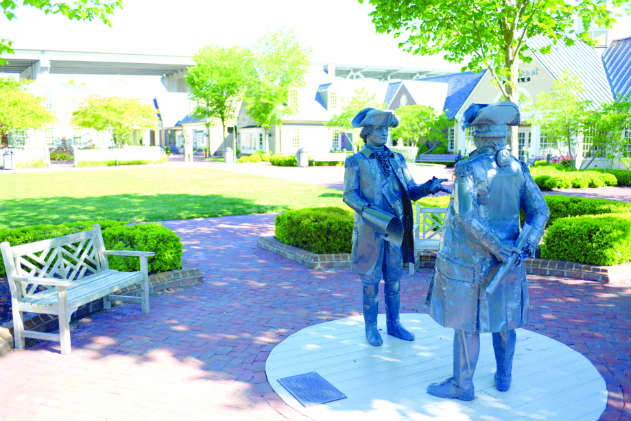The Chesapeake and the Revolutionary War
Set aside for a minute fireworks, Old Glory, boats, barbecue, and beer, and delve back in time to our nation’s beginnings. The Fourth of July brings to mind Lexington and Concord, the Declaration of Independence, Philadelphia, Valley Forge, and the list goes on. While the siege at Yorktown takes its place among top-tier Revolutionary War events, lesser-known contributions of the Chesapeake region’s brave patriots affected the outcome of the war just as significantly. What better time to connect to the Chesapeake’s revolutionary past than sailing to these harbors on Independence Day?

Annapolis
From the beginning to the end of the conflict, the Revolutionary War left its mark on Annapolis. Interested in tea parties? Annapolis had its own tea party in 1774 with the burning of the brig Peggy Stewart. Following his payment of the import tax on tea, loyalist Anthony Stewart found himself facing fierce anger and opposition from the town’s patriots. The result: Stewart set fire to his own brig, sinking it and the hated tea in Annapolis harbor. The remains of the Peggy Stewart now lie buried under Luce Hall at the U.S. Naval Academy.
Several more spots around town speak to revolutionary-era history: the homes of three signers of the Declaration of Independence still stand in downtown Annapolis. French troops under the command of the Marquis de Lafayette and the Comte de Rochambeau stayed in Annapolis off and on from 1781-1783, and historical markers around town note details from their stays.
George Washington resigned his commission as general of the Continental Army in the Maryland State House, noting in a letter to Lafayette that “at Annapolis, where Congress were then, and are now sitting, I did, on the 23rd of December present them my Commission, & made them my last bow— & on the Eve of Christmas entered [Mt. Vernon] an older man by near nine years, than when I left them, is very uninteresting to any but myself.”
Less well remembered in Chesapeake lore, however, is the story of the Maryland 400, a well-trained fighting force whose brave stand during the 1776 Battle of Brooklyn enabled the rest of Washington’s army to escape total defeat and live to fight another day. The battle was the bloodiest of the Revolutionary War, and 256 of the 400 Marylanders holding the line lost their lives. Nineteenth century historian Thomas Field claimed that the stand by the Maryland 400 was “an hour more precious to American liberty than any other.”
Their sacrifice and bravery, which earned Maryland the nickname of the “Old Line State,” are celebrated at the Old Stone House museum in Brooklyn. Local researchers sponsored by the Maryland State Archives and the Maryland Society of the Sons of the American Revolution are poring through documents in Annapolis in an effort to learn more about the individual soldiers and to foster greater recognition of the heroic story of the Maryland 400. Their findings are published online at msamaryland400.wordpress.com.

Baltimore
The Pulaski Monument in Patterson Park in Baltimore offers sculptural praise to General Casimir Pulaski, “the Father of the American Cavalry.” His accomplishments include building the Continental Army’s mounted fighting force from scratch and saving Washington’s life while enabling Continental Army troops to retreat during the Battle of Brandywine.
Yorktown
September 1781 saw one of the most decisive naval battles in American history take place off of Cape Henry. During a late afternoon engagement, the French fleet commanded by Admiral deGrasse fought a superior British fleet, damaging several ships and killing or wounding more than 300 British sailors. The fleets disengaged at sunset and maintained a stand-off until the French sailed back into the Chesapeake Bay a few days later. The British fleet then headed for New York City, leaving the French in control of the Chesapeake Bay.
The French naval victory at the Battle of the Chesapeake set the stage for success at Yorktown one month later. Continental Army troops led by Washington and French troops led by the Comte de Rochambeau successfully besieged British forces, resulting in the surrender by British General Lord Cornwallis that ultimately secured American independence. Living history and artillery demonstrations at Yorktown National Battlefield bring the closing actions in America’s fight for independence alive to visitors.
Talbot County
Born near Easton in Talbot County, Lieutenant Colonel Tench Tilghman served as a voluntary aide-de-camp to Washington throughout the Revolutionary War. A member of Washington’s military “family” alongside Alexander Hamilton and Lafayette, Tilghman accompanied Washington throughout the war. In camp, Tilghman often drafted Washington’s correspondence, spoke French with foreign officers, and performed whatever other duties were helpful to Washington and the war effort. Serving longer than any of Washington’s other aides or secretaries, he was chosen to deliver the news of Lord Cornwallis’ surrender to Congress in Philadelphia. Along the way, he became sick with an illness he never fully shook. He died in 1786, and his remains are now located in Oxford Cemetery.
The final words of his epitaph suggest something to which we can all raise a glass: “He took an early and active part in the great contest that secured the Independence of the United States of America. He was an Aide-de-Camp to his Excellency General Washington, Commander in Chief of the American Armies, and was honored with his friendship and confidence, and he was one of those whose merits were distinguished and honorably rewarded by the Congress, but still more to his Praise, he was a good man.”
By Tracy Leonard




